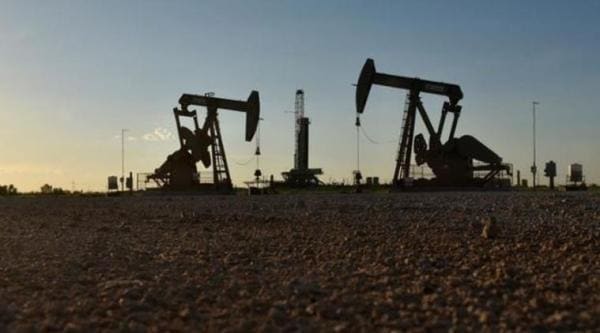Oil near 4-year high as Washington’s Iran sanctions loom
Brent has risen by around 20 per cent from the most recent lows in August.

Pump jacks operate in front of a drilling rig in an oil field in Midland, Texas U.S. August 22, 2018. REUTERS
Oil markets were firm on Tuesday, with Brent crude holding near four-year highs reached the previous day as markets adjust to the prospect of tighter supply once the U.S. sanctions against Iran kick in next month.
International benchmark Brent crude oil futures were at $85.03 per barrel at 0439 GMT, up 5 cents from their last close, and not far off the $85.45 peak reached in the previous session, the highest since November 2014.
1m 42s

Trump re-imposes sanctions on Iran
President Trump issues an executive order to reinstate the sanctions on Iran that were dropped following the 2015 nuclear deal, targeting critical sectors of the Iranian economy like petroleum.
Brent has risen by around 20 per cent from the most recent lows in August.
U.S. West Texas Intermediate (WTI) crude futures were up 24 cents, or 0.3 per cent, at $75.54 a barrel.
WTI is up by about 17 per cent since mid-August.
Sentiment was lifted by a last-gasp deal to salvage NAFTA as a trilateral pact between the United States, Mexico and Canada, rescuing a $1.2 trillion a year open-trade zone that had been about to collapse.
“Crude prices continued their meteoric rise as Canada and (the) U.S. updated the NAFTA treaty, which would augur well for economic growth,” said Sukrit Vijayakar, director of energy consultancy Trifecta.
More fundamentally, oil markets have been pushed up by looming U.S. sanctions against Iran’s oil industry, which at its most recent peak this year supplied almost 3 per cent of the world’s almost 100 million barrels of daily consumption.
Trade data in Refinitiv Eikon showed Iran’s seaborne exports in September were just 1.9 million barrels per day, the lowest level since mid-2016. “Oil prices continue to climb, supported by the nearing Iran embargo and related supply concerns,” said Norbert Ruecker, head of commodity research at Swiss bank Julius Baer.
“The supply situation looks fragile indeed, as any additional shortfall such as a deterioration of the situation in Venezuela would tighten oil supplies.”
HSBC said in its fourth quarter Global Economics outlook that “our oil analysts believe there is now a growing risk it (crude) could touch $100 per barrel.”
Washington’s sanctions are set to start on Nov. 4, and analysts say there may not be enough spare production capacity in the short-term to meet demand, potentially requiring large storage drawdowns.
“The camp of believers that $100 oil could be reached continues to expand, with spare capacity concerns continuing to grow,” said Brian Kessens, managing director at investment services firm Tortoise.
The Organization of the Petroleum Exporting Countries (OPEC), of which Iran is a member, has struggled to replace export falls from Iran, according to a Reuters survey published on Monday.
With crude prices soaring and many currencies in emerging markets, including India’s rupee and Indonesia’s rupiah declining, analysts warn that economic growth may be eroded.
“U.S. (fiscal) tightening, higher oil prices and ongoing trade frictions are all taking their taking their toll on the growth outlook,” HSBC said.











































No hay comentarios:
Publicar un comentario